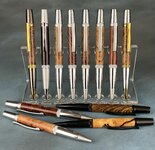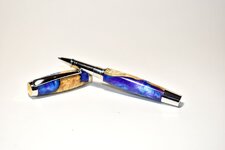Hrmm. I've been on the fence with buffing ever since I started turning pens. The few janky attempts I've made (a small buffer on a dremel, which turns way too fast and will damage not just your finish, but your actual blank) were a disaster. But I'm thinking now that ultimately this might be the way to go. Seems like it's faster, and those who've switched from MM or polish generally claim a better final finish.
Can anyone comment on the money side of things? I've generally had to replace my MM pads about once every 6-12 months, depending on how much I'm turning. I can get several years from a single purchase of their 3x4 pads. But with MM, I still have to polish, and the polish is about $30 per hundred pens. How often do you have to replace your wheels, and how long does a stick of the buffing compound last?
Is buffing any cheaper in the long run, and if not, are the differences in the final product worth the extra money?
A buffing wheel will last you for ages. You might want to pick up a $15 buffing "wheel rake" which will help you clean and trip your wheels to keep them working well. But you shouldn't have to replace wheels often (I've never replaced mine yet...I did buy some new ones, to experiment with different compounds.) Each type of compound you use, WILL need its own wheel. You never want to mix buffing compounds (i.e. rouge). I picked up a package of two 8" cotton loose leaf wheels for $25 recently. So around $12 each. They aren't expensive. You can get flannel, cotton, muslin (softer cotton), I've actually even seen a blue jeans wheel out there. There are other types, some sewn, some loose leaf, some have other structure. In any case, they are generally not very expensive. Once you have them, a set of wheels should last ages.
The buffing compounds themselves, if you are JUST doing pens, should also last you for a long time. I started with these tiny little bars, and I've gone through a few...but, they were actually probably more expensive than just buying a full sized "brick" of the stuff. I just didn't know back when I started. A full size bar of tripoli, for example, will cost you around $5. A full size BAR....yeesh, that might well last you a lifetime, if the only thing you are doing is buffing pens. Buffing larger things, like bowls, vases, that kind of stuff, you might use more of the compound. But pens...you won't use much. You might need a few types. Trip, white diamond, blue rouge. These are the ones I primarily use. If you buy the Beall buffing system, you'll get a full bar of trip, white diamond, and some carnauba wax as well (I NEVER wax my pens with natural waxes...just dulls the finish!!) If you spent say $20 on buffing compounds, it should last you years if all you do is pens. So, should be very low cost.
You will need some kind of setup to buff. The Beall 3-Wheel Buffing System is a kit that contains a #2 MT Mandrel, three wheels, and three bars of compounds. Its around $110 normally, although you can find it on sale. This works with the lathe. You can also repurpose a grinding wheel, as a two-wheel setup. Normally, I use White Diamond and Blue Rouge, and then have a separate "clean" wheel that isn't loaded with any compound, to clean off any residue from the prior two buff stages. That doesn't need to be done with a wheel, so if you have an extra grinding wheel somewhere, and don't use it, or can find one cheap used, then that will work just as well. You might need to pick up some arbor adapters to use the buffing wheels on a grinder, but those aren't very expensive ($20 maybe?)
Buffing shouldn't be expensive. That said, it doesn't eliminate sanding. FWIW, I still sand. I use Norton 400-1200 grit on resins and CA. Sometimes just 400, 600 and 800. I use small little strips...maybe 3/4" x 1 1/2" or thereabouts. So, a sheet of sandpaper lasts a lot of pens. The cost is utterly trivial.
I then also use Zona paper. I then buff out the final scratches from the 1 micron Zona. I am extremely efficient with my Zona paper. Its, oh, $10-12 a package, a package contains 6 grits in 11x8.5" sheets, and I use a set of 3/4" x 3/4" squares of Zona for each pen. Sometimes, I might use more green and white zona. Still, small three quarter inch squares. Those sheets last a LOT of pens. In fact, by my calculation, a single package of Zona paper should last 150 pens, or more. To your $30 cost, at that rate, three packages of Zona paper would sand 450 pens. In essence, a negligible cost!
In fact, with both sanding and buffing, in the long run, its a negligible cost. Per pen, its cents, really.


